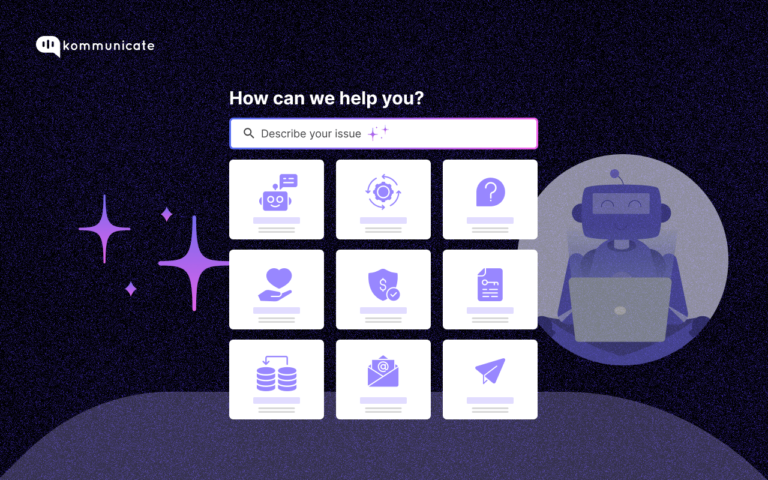Updated on December 14, 2023
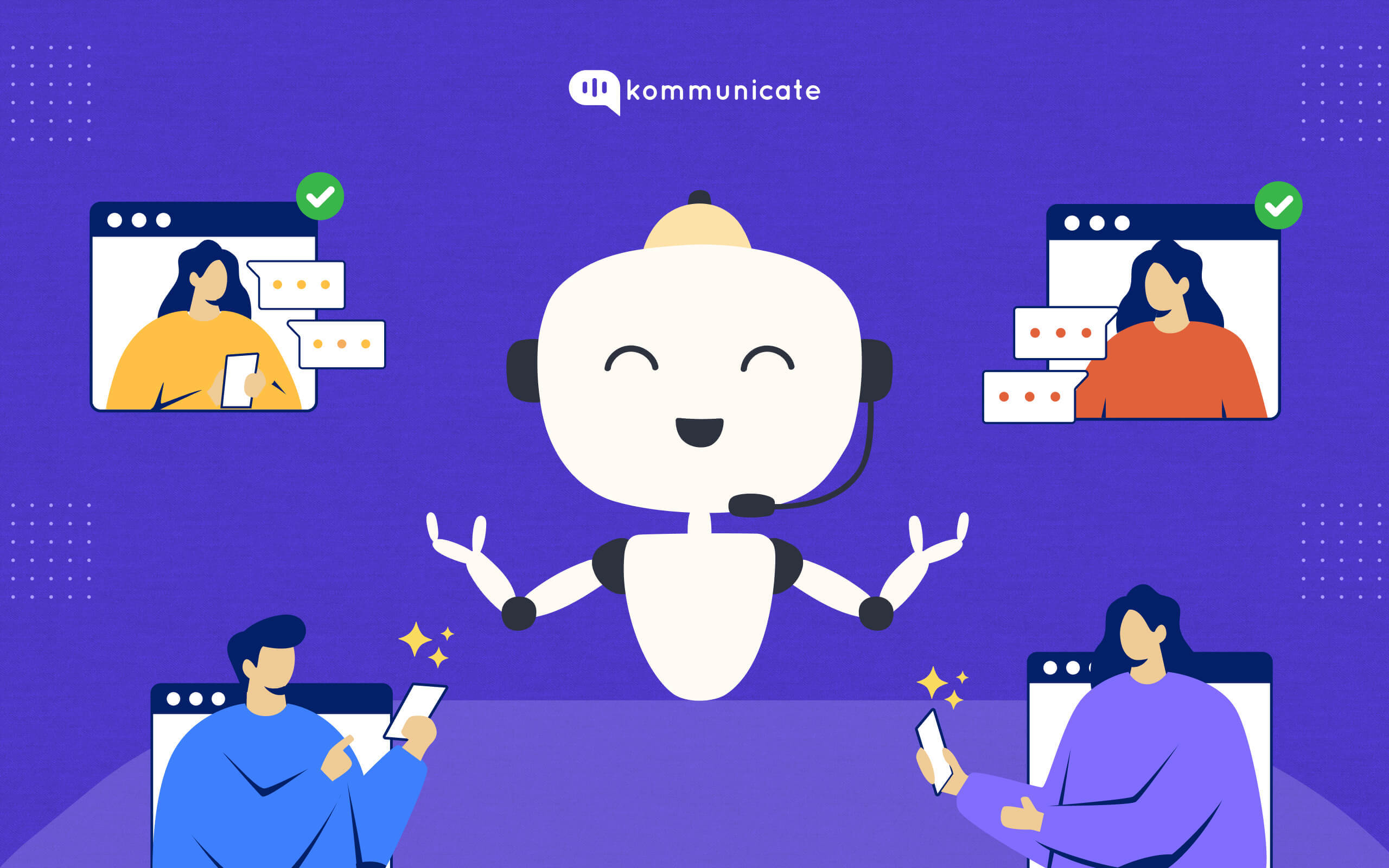
One of the hallmarks of great customer experience (CX) is excellent customer service.
Imagine buying a car, and then having to run from pillar to post to fix a minor issue such as a sticky steering wheel. It leaves a bad impression in the mind of the consumer, who, in turn, will turn into a negative ambassador for the car brand.
Poor customer service comes at a cost. Lost sales and angry customers are just the tip of the iceberg. According to this Zendesk report, three out of four customers say customer service is one the most important factors for them to feel loyal to a brand.
Providing excellent customer service is no rocket science. All you need to do is keep your ears pried to what the customer is saying and act accordingly. In this blog post, we are going to see how you can use chatbots to provide excellent customer service. Without further ado, here are 13 ways chatbots can help improve customer service.
- Chatbots are scalable
- Improvement in data collection
- Availability round the clock
- Personalized interactions
- Chatbots help in appointment booking
- Multilingual chatbots improve customer base
- Operational cost reduction
- Training costs elimination
- Lead generation
- Reduced human errors
- Order management
- Speeding up resolutions
- Meeting the customers where they hang out
1. Chatbots are scalable
If you run an e-commerce business and are running a discount during the festive season, you know how crazy things can get. Black Friday and Cyber Monday alone brought in $9.8 billion and $12.4 billion in sales in 2023, according to a report by Adobe. There is a severe peak in customer demand during this time, which comes with increased customer queries.
The only way to solve this problem is automation. Automating your customer service during the festive season ensures that your operation is up and running smoothly, and no customer is left behind. One of the best ways to automate? Chatbots!!

Chatbots are known for their ability to handle a lot of queries simultaneously, and they can do this at scale. There can be a surge in customer inquiries, and a chatbot can handle it with ease.
2. Improvement in data collection
“Data is the new oil” is a phrase you might have been hearing repeatedly over the past few years, and with good reason. Access to quality customer data gives you an edge over the competition when it comes to providing excellent customer service. And what better way to collect data than chatbots?
Customer data gives you a wealth of information about what the customer is looking for, their likes and dislikes, patterns in their behavior, and areas of improvement. A customer’s preferred language and purchase history can help you give a tailored customer experience.
Chatbots can also collect feedback from customers, which is of immeasurable value in improving customer service. Feedback helps identify areas of improvement, and also chatbot responses.
Using powerful NLP engines, chatbots can also do sentiment analysis and gather real-time insights. Using sentiment analysis, chatbots can then tailor their responses and understand customer emotions.
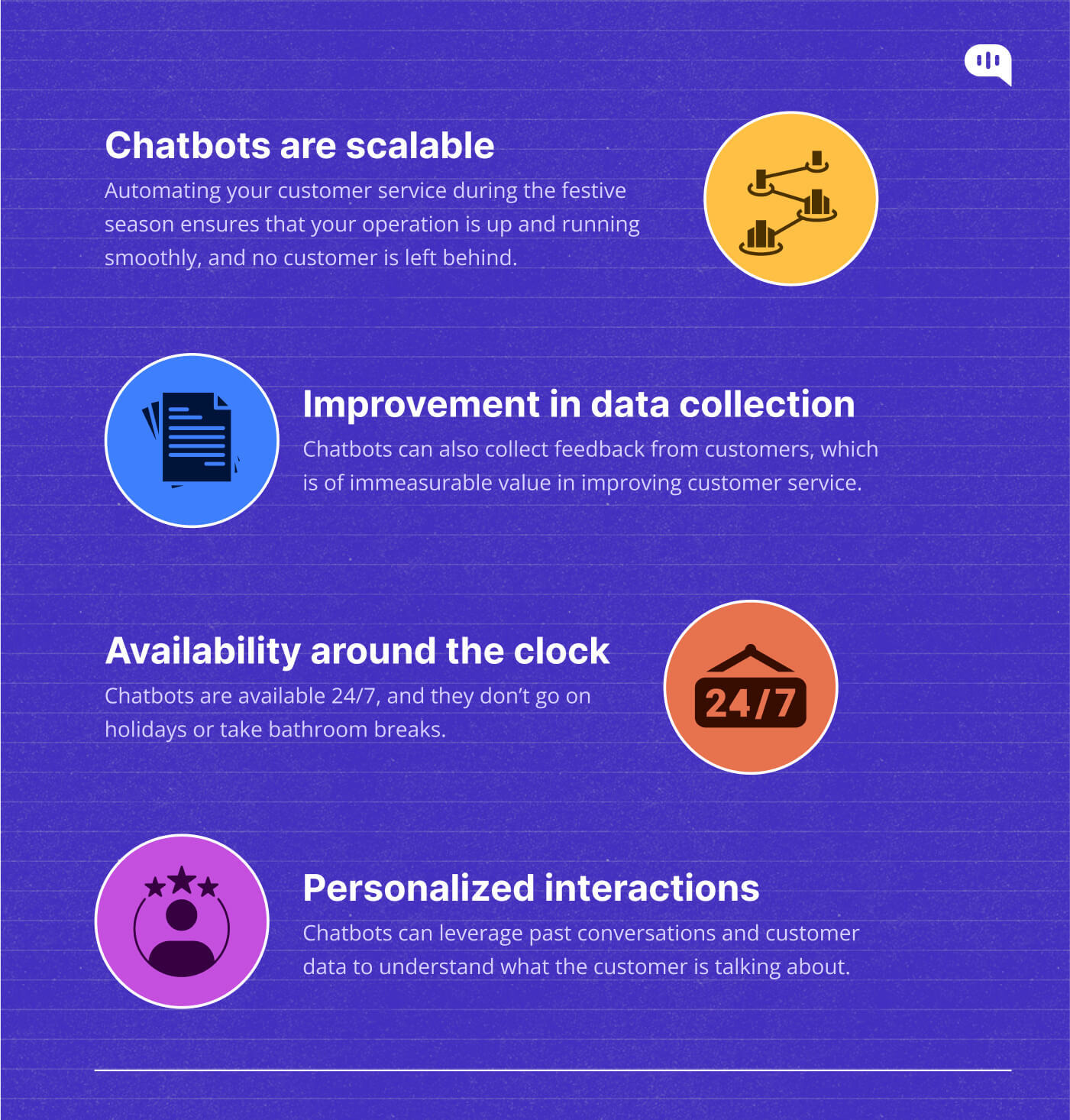
3. Availability around the clock
A growing business needs to account for a global audience, and many times, your customers may not be sitting in the same time zone as you. How do you then ensure that you provide the same level of customer service to someone sitting 1000 miles away? The answer is again chatbots.
Chatbots are available 24/7, and they don’t go on holidays or take bathroom breaks. Chatbots don’t fall sick, are not away from their desks for extended periods, or have an “off-day” when they just don’t work.
There may be technical glitches while implementing a new chatbot solution. This is just a one-off problem that your chatbot provider such as Kommunicate can solve.
4. Personalized interactions
I was purchasing the second book in the Robert Galbraith series the other day from Amazon, and the website has a nice section where they club “Frequently bought together,” items. This is a great way to upsell and imagine you have a chatbot on your website doing this.

AI Chatbots can today understand the context of any conversation better than ever, especially those that are powered by LLMs such as ChatGPT. These chatbots can leverage past conversations and customer data to understand what the customer is talking about.
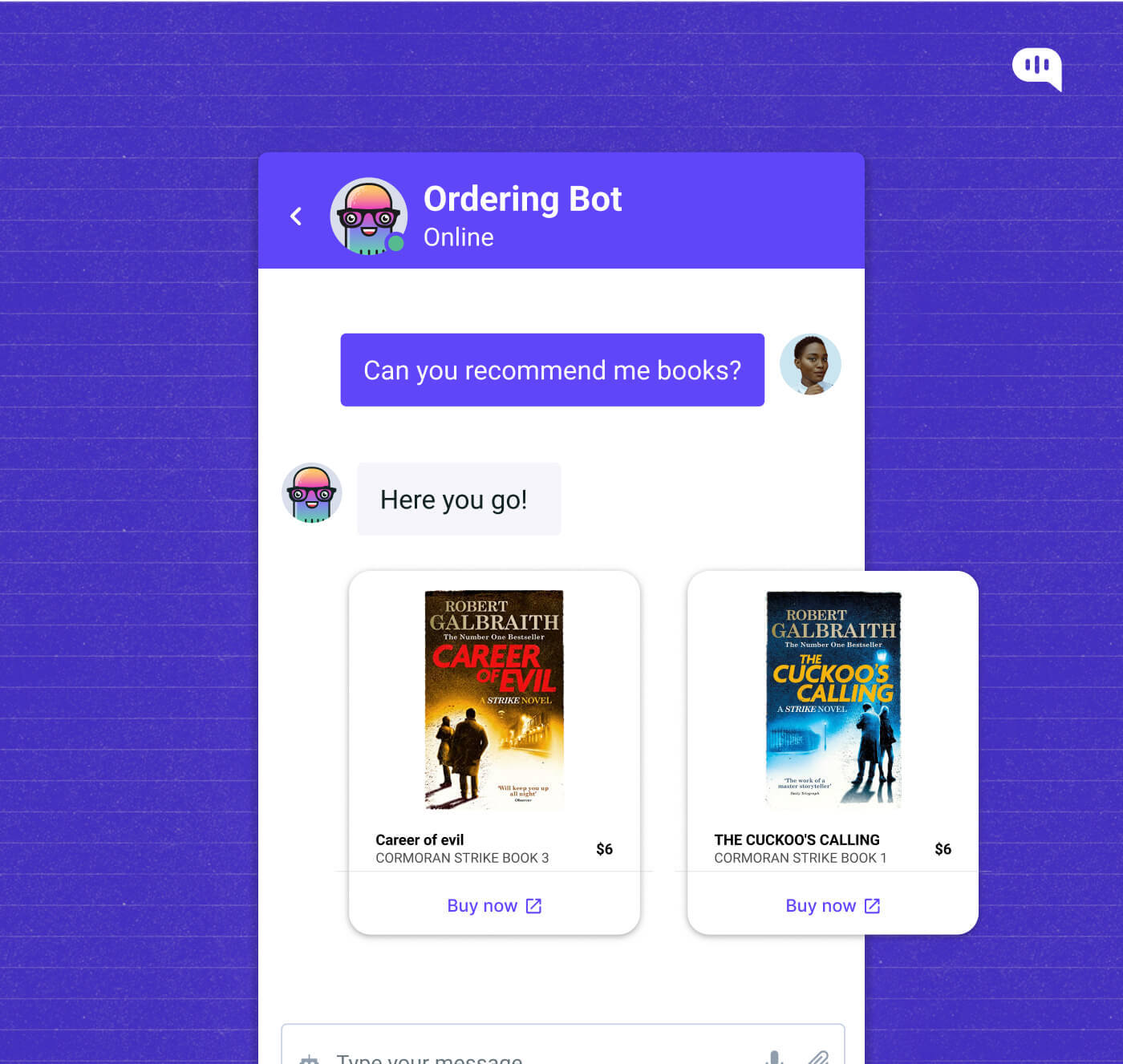
Chatbots help deliver personalization at scale, which, in turn, can lead to an increase in customer engagement and purchase likelihood. Chatbots can also proactively reach out to customers with personalized offers and recommendations. This boosts attentiveness and fosters a sense of customer engagement.
5. Chatbots can help book appointments
One of the key aspects where human agents find themselves in a corner is appointment scheduling, especially for products or services that are in high demand. Missed appointments in the US healthcare system alone cost a whopping $150 billion, according to a Forbes report.
To tackle this multi-billion dollar problem, companies can seriously consider investing in a chatbot solution. Using sophisticated NLP technologies, chatbots can guide users through various available time slots, after getting an idea about their preferences. This will significantly reduce the burden on human agents, who can then focus on providing a superior customer experience.
Chatbots in appointment scheduling are a win-win not just for businesses, but for customers too. Customers benefit from immediate responses from the bot, saving them precious time. This will lead to increased customer satisfaction and loyalty.
6. Multilingual chatbots improve customer base
Not all of your customers speak English. In fact, according to Wikipedia, Mandarin Chinese is the most spoken language in the world, closely followed by Spanish and then English. So if you want to cater to a truly global audience, you better start speaking their language.
Hiring and training customer support executives across geographies or different time zones may not be feasible or practical. This holds, especially for smaller companies with a limit on their budgets. Multilingual chatbots come to the rescue here.
With multilingual chatbots, customers feel that a business is making that extra effort to stay connected to them. This will improve customer satisfaction and also ease the efforts of the customer service team. Multilingual chatbots also make business sense, since customers need not go looking elsewhere for a product or service if you serve it to them in their language via the bot. Everybody wins.
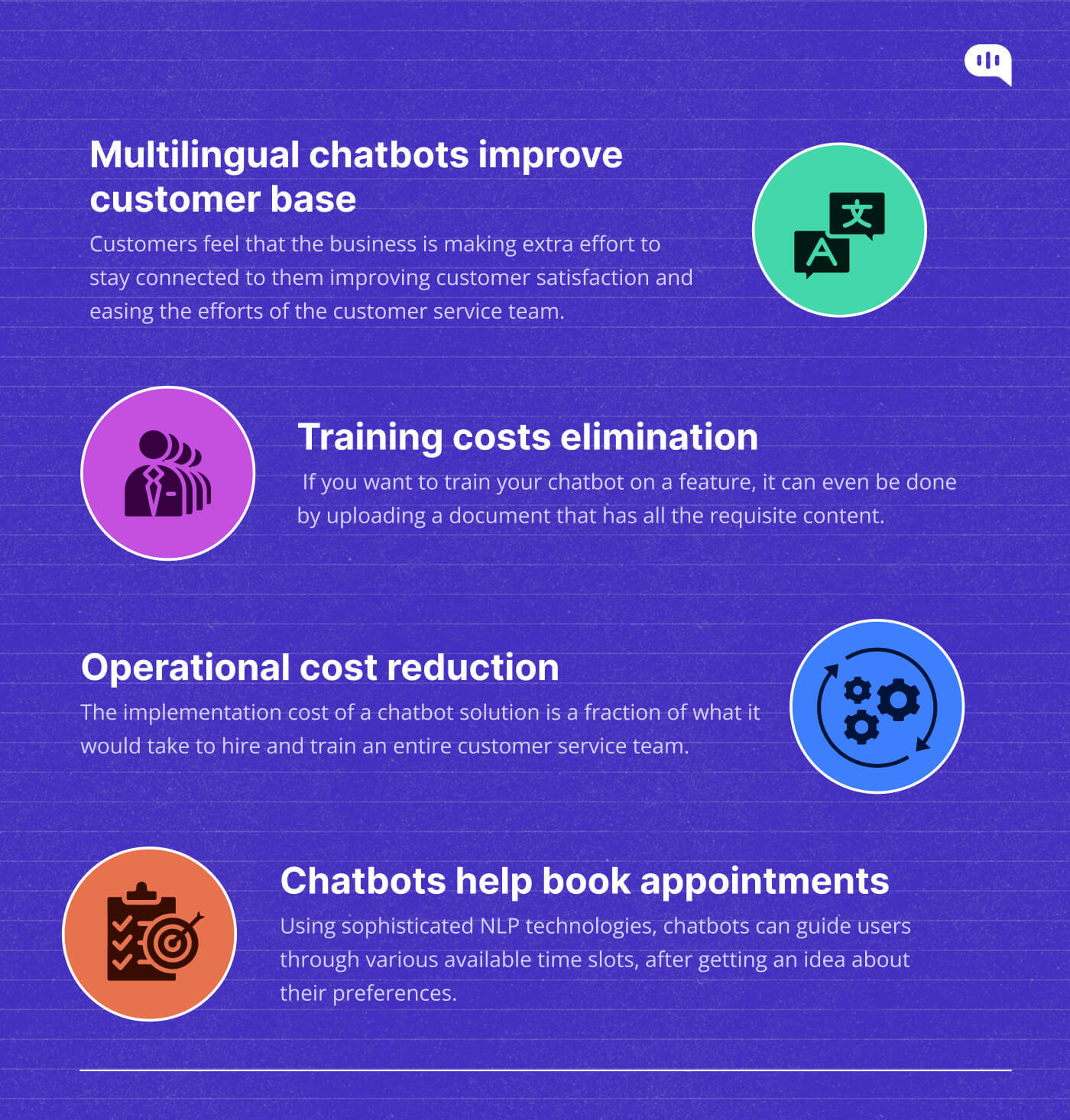
7. Operational cost reduction
Labor cost is one of the most expensive aspects of running any business. Cash flow problems have been often cited as one of the key reasons why many new businesses fail, and labor cost is a significant contributor to this. To reduce operational costs, it is best to keep your labor costs as low as possible in the early part of your journey.
Companies can eliminate payroll costs, training costs, etc. by introducing one chatbot in place of one or more human agents. For instance, TelOne, one of the largest telecommunications players in Zimbabwe was able to move a lot of their agents from the self-help queries team after the introduction of a chatbot.
Chatbots can replace entire teams. The implementation cost of a chatbot solution is a fraction of what it would take to hire and train an entire customer service team. This makes an investment in a chatbot solution not just a financial, but an emotional decision. After all, no one likes to let go of an employee.
8. Training costs elimination
A study by SHRM notes that the average cost of training a new hire is approximately $4100. For half of that cost, you can implement Kommunicate’s chatbots in the Advanced plan (check out our pricing page). Once a new hire starts operating, you have to continuously monitor them and train them on new features of your product.
Chatbots are not as complicated. If you want to train your chatbot on a feature, it can even be done by uploading a document that has all the requisite content. A few chatbots offer a document scanning feature powered by AI. Here the chatbot can give answers to an entire set of questions, with training happening on the contents of the doc.
Training also ensures that chatbots have consistency in responses, and this leads to a more standardized and efficient customer service experience.
9. Lead generation
Every single lead for your company is a business opportunity that you cannot miss. Generating and qualifying leads has become harder than ever, ask any SDR. This is another sphere that chatbots can help in. Chatbots can ask targeted questions, building meaningful relationships with customers.
Once a chatbot learns enough about a customer, it can then assign that customer to a member of your sales team. This way of qualifying leads will lead to a greater chance of conversion since your SDR already has a lot of information about the prospect.
Knowing your customers’ pain points, their likes and dislikes, and their past purchase history, will help your sales team move your customers easily through the funnel. Businesses can also set predefined criteria for a customer interacting with their chatbot. For instance, only those who have a business email can ask the chatbot a question. This will help the business better qualify leads.
10. Reduced human errors
When your customer service team chiefly consists of human agents, there are bound to be instances where human errors creep in. This can differ in severity, from a small information error such as a botched delivery date, to a billing error that can cost your business thousands of dollars. Chatbots don’t make such errors.
Chatbots ensure that the information that you give out to the customer is consistent and accurate, resulting in standardization of responses. This improves the trust that the customer has in your brand. Using AI-powered chatbots to automate routine queries such as data entry and information retrieval, you are freeing up human agents to do more complex work.
11. Order management
Customer service teams usually struggle to manage orders, especially during peak seasons when the volume is high. Customers may want to update or modify their address and make changes to their shipping options, and payment methods among a host of other things. All this can now be done with the help of a chatbot.
You can also program a chatbot so that it can help customers track their orders 24/7. This further reduces the dependency on your customer service team. Customers can also initiate returns and replacement requests directly through the chatbot.
Order verification is another aspect of that chatbots can play a crucial role. Chatbots can verify customer and order details, reducing the possibility of fraudulent transactions. If a particular order is not available in the inventory, chatbots can communicate this information to the customer.
12. Speeding up resolutions
Customers always are short on time, and so are customer support agents. No one likes to have lengthy phone calls or long email threads that go on and on. Time To Resolution (TTR) is an important customer service metric, and a longer TTR can negatively impact your CSAT scores.

Chatbots are excellent when it comes to guiding users through troubleshooting steps and providing real-time solutions. Using intelligent algorithms, chatbots can easily identify the problem that a customer is facing and give an instant solution. With a quick customer response, customers are left with the view that a company cares about them.
13. Meeting the customers where they hang out
Customer service agents have the limitation that they can only interact with a customer through a predefined channel, such as a voice call, chat, or email. However, a customer may not always prefer to interact with a business over these channels. In fact, according to a Pew Research report, 96% of customers look for negative reviews specifically.
Social media is the new storefront, and most of the millennials hang out on Meta, X, Insta, or Linkedin, wanting to talk to your brand when they have a question. This is another advantage of implementing chatbots. Using an omnichannel approach, chatbots can talk to your customers on the platforms that they are the most active in.
When chatbots integrate with your existing channels, such as Messenger, Line, or Telegram, they can provide a uniform experience to the customer. Hanging out where your customers do and providing a multi-touch experience will increase your brand’s visibility. At the same time, customers will see your business as one that is eager to hear them.
And there you have it. 13 ways chatbots can positively impact your customer service. All of the methods that are mentioned above are easy to implement, and the gains are immediate to notice. Automation is never just about saving costs or adding value. The end goal is to create a business that stands the test of time.
Redefine your experience with chatbots
Your customer experience is what matters in the end. Not the fancy look of your website, not the amount of discounts you offer, or anything else your marketing team would do to firefight. Implementing a customer service chatbot is one way you can improve your customer experience, but you must also keep listening to the customer, whichever channel they prefer to contact you in.
Dheeraj is passionate about all things Search, and is currently an Sr. SEO manager at Kommunicate. His interests lie at the intersection of technology and human psychology, and his writings reflect his interests. When not researching the latest trends in SEO, you can find him sipping coffee, cracking jokes, and reminding everyone that “Search is serious.. guys.”



